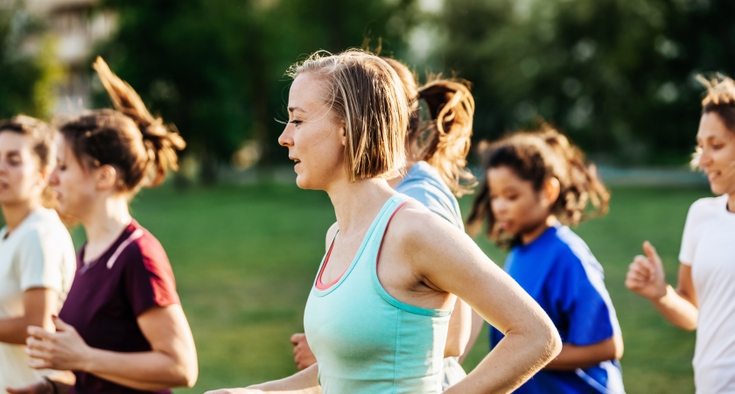Signing up for a gym membership and then striding in to get going for the first time can be intimidating. But it can also be a reliable way to build an on-ramp to regular exercise and strength-building that can lead to a better quality of life well into your later years.
Working out for at least 30 minutes a day can even help improve balance and prevent the risk of falls and fractures, the federal Department of Health and Human Services reports.
A consistent regimen of cardio and strength training can also prevent or control heart disease, stroke, high blood pressure and other conditions. Brisk walking, combined with resistance training including leg and chest presses, can improve your overall health as you move.

“The gym is a great motivator for staying focused while working out, whereas it’s easier to slack off and get distracted when trying to exercise at home,” says primary care sports medicine physician Dr. Zach Sandbulte of Novant Health Orthopedics & Sports Medicine - Clemmons.
But older adults should take care by starting slowly, and gradually build up to a consistent discipline. Talk to your doctor before diving in, especially if you have a preexisting condition like heart disease or osteoporosis. Chances are excellent, however, that they’ll be thrilled you’re ready to start exercising more.
Sandbulte specializes in nonoperative treatment of sports injuries. Here, he explains how to approach the gym as a first-timer.
Don't let joint pain keep you from enjoying life.
Tips for going to the gym for the first time
Ease in, then step it up.
It’s important to make sure you’re working out safely. You don’t necessarily need a lot of equipment when starting out. And if you overdo it right off the bat, you’re more likely to hate it and quit.
But certainly as you progress you’ll want access to equipment that provides a full-body workout. Some of us love machines, while others are overwhelmed by a sea of contraptions. Try a few and see what you think. Also know that basic dumbbells and resistance bands can give you a full workout. One advantage to this route: You’re working on balance and core strength when exercising while standing.
The general rule when starting out is to go light. Have a consistent warmup routine. That should start with 10 minutes of stretching to reduce stiffness in your legs, neck, back and shoulders.
Move on to an exercise machine or dumbbells, and begin with high repetitions using light weight. For each muscle group, shoot for two sets of 12 reps. Over the course of several weeks, you can move toward lifting more weight with fewer reps, as long as your movements are controlled and aren’t causing discomfort.
Consider a certified personal trainer.
The biggest part of a workout routine is understanding what you’re doing, why you’re doing it and what the risks are. That’s where a personal trainer can be helpful for someone who hasn’t spent a lot of time in the gym. A trainer who is especially mindful of orthopedic issues can help educate you on targeted exercises as you work to set and meet your fitness goals.
Keep moving, and stay hydrated.
Best doctors. Amazing nurses. Remarkable care.
Taking shorter breaks between sets keeps your heart rate up and naturally provides some cardio as you work on resistance training. This can make for a better workout in less time. Leave your phone in the car or a locker and resist the urge to scroll between workout sets. (You’ll see lots of scrolling at the gym. Lots.)
Staying hydrated before and during a workout is especially vital for those of us who are older. After exercising, the two most important things to consume are glycogen (sugar) and protein. The best way to do that? Drink a glass of chocolate milk. For people with diabetes, we have to be careful about that, but in general chocolate milk is a great thing for your recovery within 30 minutes after a workout.
>>> We pause for a pro-tip from Novant Health Registered Dietitian at Kelly Homesley at Bariatric Solutions - Elizabeth in Charlotte: Choose Fairlife chocolate milk which has half of the sugar and double the protein compared to regular chocolate milk. Also Fairlife is lactose free.
Machines vs. free weights
Both offer the same benefits, but the difference comes down to proper balance. Machines ensure better form, control and targeting of individual muscle groups, while minimizing the chance of injury. With machines, there’s no risk of dropping anything. And it’s a more effective approach for beginners, who can progress to lifting free weights once they’re comfortable.
A beginner's workout to safely get started
Listen to your body, especially when approaching your first workout. Here’s one plan to get moving:
Warming up: After stretching, get your heart rate up with 10 minutes on the treadmill or stationary bike at a slow pace.
Strength training: Machines offer more support and are safer than using free weights. Start light, and don’t be in a rush to increase the amount of weight.
- Seated leg presses: 2 sets of 12 reps
- Chest presses: 2 sets of 12 reps
- Lat pulldowns: 2 sets of 12 reps
- Dumbbell bicep curls: 2 sets of 12 reps
Cardio: Exercise for 20 brisk minutes on the treadmill, elliptical machine or stationary bike.
Cooling down: End your workouts with 10 minutes of stretching to reduce tightness and maintain joint strength and flexibility.
Also, consider finding a workout buddy so you can hold each other accountable to showing up instead of constantly finding a “good” reason to skip. Maybe you treat yourselves to a coffee or lunch one day a week.













